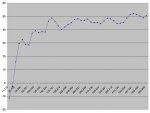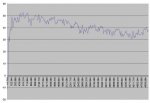Chili
Site Moderator
I finished building Studio Cubito in my garage, packed it full of junk and moved in. See this thread:
https://homerecording.com/bbs/showthread.php?t=279814
I was fortunate enough to borrow the company's Bruel and Kjaer sound meter and took some measurements of the room's response. Now I need help interpreting the results.
This is a small cube-shaped room, hence the name, dimensions are 9Wx11Lx10H. Sound source is a wav file of Pink Noise played through my DAW at levels near 65db, based on the meter. I use Event ALP5's which have a bandwidth of ~50hz - 20khz, set as near fields and the mic was in the sitting position.
The measurement spectrum is 11hz - 5khz and charted as dB re 20uPa. I loaded the data in Excel and charted the results. Then I charted a subset for 11hz - 500hz.
i see the peaks and valleys, but don't know if they are of concern or not. I know I don't have any bass response, are the speakers too limiting to be a subjective test? For my size room, I believe the trouble spots are around 240hz and 500hz.
Anyways, here are the screenshots. I can email the excel spreadsheet if any is interested.
Thanks for any thoughts.
11hz - 500hz

11hz - 5khz

https://homerecording.com/bbs/showthread.php?t=279814
I was fortunate enough to borrow the company's Bruel and Kjaer sound meter and took some measurements of the room's response. Now I need help interpreting the results.
This is a small cube-shaped room, hence the name, dimensions are 9Wx11Lx10H. Sound source is a wav file of Pink Noise played through my DAW at levels near 65db, based on the meter. I use Event ALP5's which have a bandwidth of ~50hz - 20khz, set as near fields and the mic was in the sitting position.
The measurement spectrum is 11hz - 5khz and charted as dB re 20uPa. I loaded the data in Excel and charted the results. Then I charted a subset for 11hz - 500hz.
i see the peaks and valleys, but don't know if they are of concern or not. I know I don't have any bass response, are the speakers too limiting to be a subjective test? For my size room, I believe the trouble spots are around 240hz and 500hz.
Anyways, here are the screenshots. I can email the excel spreadsheet if any is interested.
Thanks for any thoughts.
11hz - 500hz

11hz - 5khz



